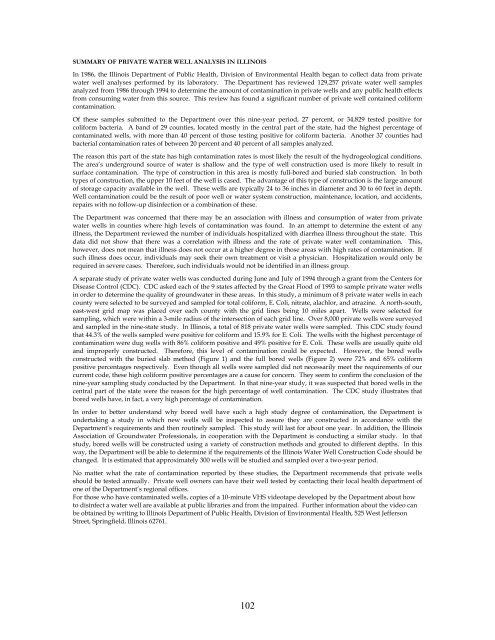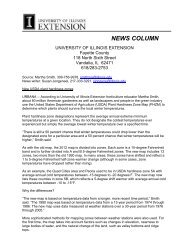Carlyle Lake Final Plan.pdf - Fayette County Soil & Water ...
Carlyle Lake Final Plan.pdf - Fayette County Soil & Water ...
Carlyle Lake Final Plan.pdf - Fayette County Soil & Water ...
You also want an ePaper? Increase the reach of your titles
YUMPU automatically turns print PDFs into web optimized ePapers that Google loves.
SUMMARY OF PRIVATE WATER WELL ANALYSIS IN ILLINOIS<br />
In 1986, the Illinois Department of Public Health, Division of Environmental Health began to collect data from private<br />
water well analyses performed by its laboratory. The Department has reviewed 129,257 private water well samples<br />
analyzed from 1986 through 1994 to determine the amount of contamination in private wells and any public health effects<br />
from consuming water from this source. This review has found a significant number of private well contained coliform<br />
contamination.<br />
Of these samples submitted to the Department over this nine-year period, 27 percent, or 34,829 tested positive for<br />
coliform bacteria. A band of 29 counties, located mostly in the central part of the state, had the highest percentage of<br />
contaminated wells, with more than 40 percent of those testing positive for coliform bacteria. Another 37 counties had<br />
bacterial contamination rates of between 20 percent and 40 percent of all samples analyzed.<br />
The reason this part of the state has high contamination rates is most likely the result of the hydrogeological conditions.<br />
The area’s underground source of water is shallow and the type of well construction used is more likely to result in<br />
surface contamination. The type of construction in this area is mostly full-bored and buried slab construction. In both<br />
types of construction, the upper 10 feet of the well is cased. The advantage of this type of construction is the large amount<br />
of storage capacity available in the well. These wells are typically 24 to 36 inches in diameter and 30 to 60 feet in depth.<br />
Well contamination could be the result of poor well or water system construction, maintenance, location, and accidents,<br />
repairs with no follow-up disinfection or a combination of these.<br />
The Department was concerned that there may be an association with illness and consumption of water from private<br />
water wells in counties where high levels of contamination was found. In an attempt to determine the extent of any<br />
illness, the Department reviewed the number of individuals hospitalized with diarrhea illness throughout the state. This<br />
data did not show that there was a correlation with illness and the rate of private water well contamination. This,<br />
however, does not mean that illness does not occur at a higher degree in those areas with high rates of contamination. If<br />
such illness does occur, individuals may seek their own treatment or visit a physician. Hospitalization would only be<br />
required in severe cases. Therefore, such individuals would not be identified in an illness group.<br />
A separate study of private water wells was conducted during June and July of 1994 through a grant from the Centers for<br />
Disease Control (CDC). CDC asked each of the 9 states affected by the Great Flood of 1993 to sample private water wells<br />
in order to determine the quality of groundwater in these areas. In this study, a minimum of 8 private water wells in each<br />
county were selected to be surveyed and sampled for total coliform, E. Coli, nitrate, alachlor, and atrazine. A north-south,<br />
east-west grid map was placed over each county with the grid lines being 10 miles apart. Wells were selected for<br />
sampling, which were within a 3-mile radius of the intersection of each grid line. Over 8,000 private wells were surveyed<br />
and sampled in the nine-state study. In Illinois, a total of 818 private water wells were sampled. This CDC study found<br />
that 44.3% of the wells sampled were positive for coliform and 15.9% for E. Coli. The wells with the highest percentage of<br />
contamination were dug wells with 86% coliform positive and 49% positive for E. Coli. These wells are usually quite old<br />
and improperly constructed. Therefore, this level of contamination could be expected. However, the bored wells<br />
constructed with the buried slab method (Figure 1) and the full bored wells (Figure 2) were 72% and 65% coliform<br />
positive percentages respectively. Even though all wells were sampled did not necessarily meet the requirements of our<br />
current code, these high coliform positive percentages are a cause for concern. They seem to confirm the conclusion of the<br />
nine-year sampling study conducted by the Department. In that nine-year study, it was suspected that bored wells in the<br />
central part of the state were the reason for the high percentage of well contamination. The CDC study illustrates that<br />
bored wells have, in fact, a very high percentage of contamination.<br />
In order to better understand why bored well have such a high study degree of contamination, the Department is<br />
undertaking a study in which new wells will be inspected to assure they are constructed in accordance with the<br />
Department’s requirements and then routinely sampled. This study will last for about one year. In addition, the Illinois<br />
Association of Groundwater Professionals, in cooperation with the Department is conducting a similar study. In that<br />
study, bored wells will be constructed using a variety of construction methods and grouted to different depths. In this<br />
way, the Department will be able to determine if the requirements of the Illinois <strong>Water</strong> Well Construction Code should be<br />
changed. It is estimated that approximately 300 wells will be studied and sampled over a two-year period.<br />
No matter what the rate of contamination reported by these studies, the Department recommends that private wells<br />
should be tested annually. Private well owners can have their well tested by contacting their local health department of<br />
one of the Department’s regional offices.<br />
For those who have contaminated wells, copies of a 10-minute VHS videotape developed by the Department about how<br />
to disinfect a water well are available at public libraries and from the impaired. Further information about the video can<br />
be obtained by writing to Illinois Department of Public Health, Division of Environmental Health, 525 West Jefferson<br />
Street, Springfield, Illinois 62761.<br />
102



